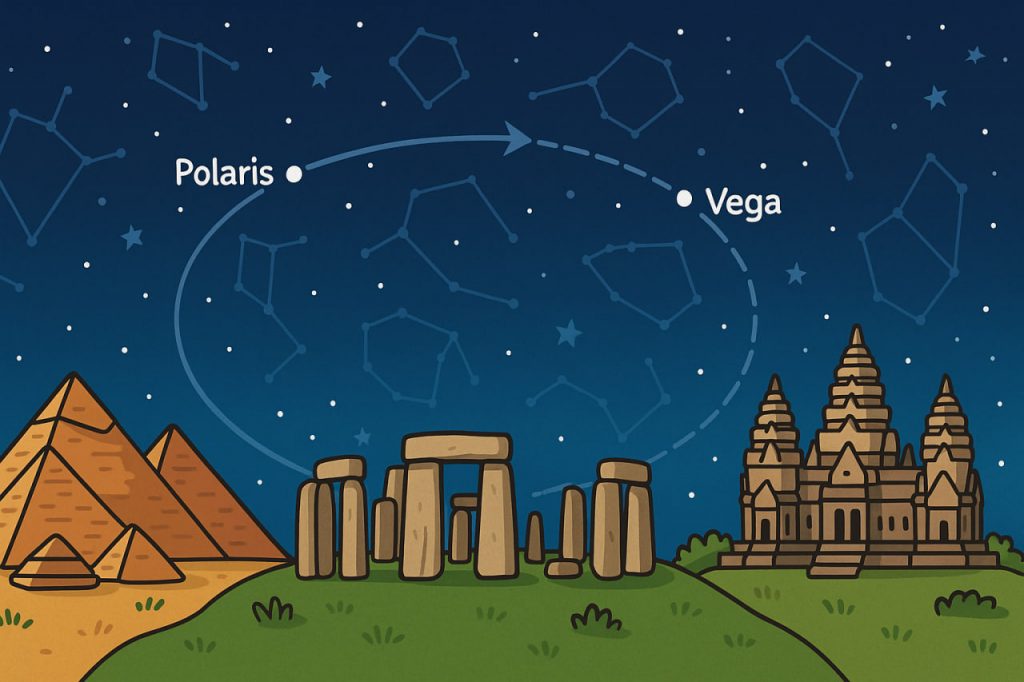Long before the invention of telescopes or modern astronomy, ancient civilizations observed the slow dance of the stars. Across continents, they built monumental structures aligned with celestial bodies, recording movements that occur over thousands of years. Many of these sites — from the pyramids of Egypt to temples in South America and Asia — seem to reflect knowledge of the precessional cycle, Earth’s slow 26,000-year axial wobble. This knowledge hints that ancient cultures possessed an unexpectedly advanced understanding of cosmic time.
What Is the Precessional Cycle?
The precessional cycle is a gradual shift in the orientation of Earth’s axis, causing the position of stars and constellations to change over millennia. This movement means that the North Star changes over time, and the constellations marking the equinoxes slowly drift through the zodiac — a phenomenon known as the precession of the equinoxes.
Ancient astronomer Hipparchus of Nicaea first described it scientifically around 130 BCE, but evidence suggests that earlier civilizations had already incorporated precessional knowledge into their sacred architecture.
The Pyramids of Giza and the Stars of Orion
Perhaps the most famous example of astronomical alignment is the Giza Pyramid Complex in Egypt. The three main pyramids — Khufu, Khafre, and Menkaure — mirror the layout of Orion’s Belt. Around 10,500 BCE, during the Age of Leo, these stars aligned precisely with the pyramids and the Sphinx, which faces directly east toward the rising Sun at the spring equinox.
This date also corresponds to a precessional era when Orion (symbol of Osiris) was low on the horizon, suggesting that the ancient Egyptians encoded cosmic cycles of rebirth into stone.
Göbekli Tepe: The Oldest Precessional Observatory
Located in southeastern Turkey, Göbekli Tepe dates to around 9600 BCE, predating Stonehenge by 6,000 years. Its circular enclosures and carved pillars depict animals and symbols that may represent constellations, such as Scorpio and Sagittarius.
Astronomers and archaeologists suggest the builders tracked the precession of the equinoxes, marking the transition between cosmic ages. Some carvings even align with the Tau Herculids meteor shower and celestial events that occurred over 12,000 years ago.
Stonehenge: Tracking the Sun and the Ages
The Stonehenge complex in England, built between 3000 and 2000 BCE, is primarily known for its solstitial alignments, but deeper analysis reveals patterns consistent with long-term celestial tracking.
The Aubrey holes and trilithons appear to mark not only solar and lunar cycles but also the gradual shift of sunrise and sunset points due to precession. Some researchers argue that successive generations of builders maintained this knowledge over centuries, preserving an oral and architectural record of cosmic time.
The Mayan and Egyptian Zodiacal Ages
The Maya civilization in Mesoamerica also recorded time in cycles that resemble precessional patterns. Their Long Count Calendar, spanning approximately 26,000 years, divides cosmic time into “Great Ages.” This mirrors the precessional cycle that causes the equinox to shift through the zodiac — known in modern astrology as the transition between ages such as Pisces and Aquarius.
Similarly, Egyptian texts from the Temple of Dendera refer to Zep Tepi, “the First Time,” when gods ruled and Orion rose at the equinox — another reflection of precessional understanding.
Angkor Wat and the Celestial Serpent
In Cambodia, the Angkor Wat temple complex, constructed in the 12th century CE, is aligned with the constellation Draco and features galleries that encode precessional values in their design.
Studies by archaeoastronomers show that its architecture reflects a 26,000-year precessional constant through symbolic measurements of towers and distances — possibly linking cosmic order to royal authority and timekeeping.
The Nazca Lines and Cosmic Alignment
Across the Pacific, the Nazca Lines in Peru stretch across 500 square kilometers of desert, forming giant geometric patterns and figures of animals. Some align precisely with the rising or setting of certain stars thousands of years ago, suggesting knowledge of the long-term drift of constellations.
While their exact purpose remains debated, the precision of these alignments supports the idea that the Nazca people tracked celestial cycles over generations.
A Global Pattern of Cosmic Awareness
What unites these ancient sites — from Egypt to Turkey, Britain, and the Americas — is their shared orientation toward the heavens and their apparent recognition of cycles far longer than a human lifetime. Such synchronization across cultures implies that ancient observers recognized precession as a measure of great cosmic ages, sometimes referred to as “Platonic Years.”
Interesting Facts
- One complete precessional cycle lasts approximately 25,772 years, often rounded to 26,000 years.
- Around 12,000 BCE, the pole star was Vega instead of Polaris.
- Ancient cultures often used solar temples and star markers to record the slow drift of constellations.
- The “Ages” of astrology — like Aquarius or Pisces — each last about 2,160 years, one-twelfth of the precessional cycle.
- Some scholars believe ancient myths of world floods or resets may symbolize transitions between precessional ages.
Glossary
- Precession of the equinoxes — the slow drift of Earth’s axis causing the equinox points to move through the zodiac.
- Zep Tepi — an Egyptian term meaning “First Time,” referring to cosmic renewal cycles.
- Platonic Year — the 26,000-year precessional cycle of Earth’s wobble.
- Archaeoastronomy — the study of how ancient cultures understood and used astronomical phenomena.
- Celestial alignment — architectural design based on star or solar positioning.


